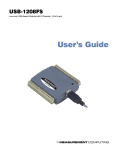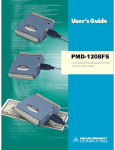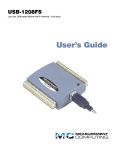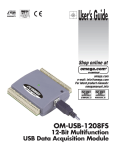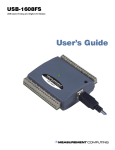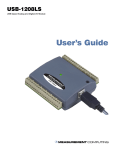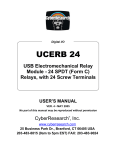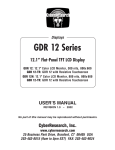Download CyberResearch UMDAS 0802DA User`s manual
Transcript
® Data Acquisition UMDAS 0802DA USB Data Acquisition Module - 8 Channels of 48kHz 13-bit A/D, 16 DIO, with 2 channels of 12-bit D/A USER’S MANUAL VER. 1.1 • January 2006 No part of this manual may be reproduced without permission ® CyberResearch , Inc. www.cyberresearch.com 25 Business Park Dr., Branford, CT 06405 USA 203-483-8815 (9am to 5pm EST) FAX: 203-483-9024 ® CyberResearch Data Acquisition UMDAS 0802DA ©Copyright 2006 All Rights Reserved. January, 1 2006 The information in this document is subject to change without prior notice in order to improve reliability, design, and function and does not represent a commitment on the part of CyberResearch, Inc. In no event will CyberResearch, Inc. be liable for direct, indirect, special, incidental, or consequential damages arising out of the use of or inability to use the product or documentation, even if advised of the possibility of such damages. This document contains proprietary information protected by copyright. All rights are reserved. No part of this manual may be reproduced by any mechanical, electronic, or other means in any form without prior written permission of CyberResearch, Inc. Trademarks “CyberResearch,” and “UMDAS 0802DA,” are trademarks of CyberResearch, Inc. Other product names mentioned herein are used for identification purposes only and may be trademarks and/or registered trademarks of their respective companies. • NOTICE • CyberResearch, Inc. does not authorize any CyberResearch product for use in life support systems, medical equipment, and/or medical devices without the written approval of the President of CyberResearch, Inc. Life support devices and systems are devices or systems which are intended for surgical implantation into the body, or to support or sustain life and whose failure to perform can be reasonably expected to result in injury. Other medical equipment includes devices used for monitoring, data acquisition, modification, or notification purposes in relation to life support, life sustaining, or vital statistic recording. CyberResearch products are not designed with the components required, are not subject to the testing required, and are not submitted to the certification required to ensure a level of reliability appropriate for the treatment and diagnosis of humans. CyberResearch, Inc. 25 Business Park Drive Branford, CT USA iii P: (203) 483-8815; F: (203) 483-9024 www.cyberresearch.com ® CyberResearch Data Acquisition UMDAS 0802DA Intentionally Blank iv ©Copyright 2006 CyberResearch, Inc. Table of Contents Preface About this User's Guide ......................................................................................................................vi What you will learn from this user's guide ........................................................................................................vi Conventions in this user's guide ........................................................................................................................vi Chapter 1 Introducing the UMDAS 0802DA ..................................................................................................... 1-1 UMDAS 0802DA block diagram................................................................................................................... 1-2 Software features ............................................................................................................................................ 1-2 Connecting a UMDAS 0802DA to your computer is easy.............................................................................. 1-3 Chapter 2 Installing the UMDAS 0802DA.... .......................................................................................................... 2-1 What comes with your UMDAS 0802DA shipment? .................................................................................... 2-1 Hardware ....................................................................................................................................................................... 2-1 Additional documentation.............................................................................................................................................. 2-1 Unpacking the UMDAS 0802DA .................................................................................................................. 2-2 Installing the software .................................................................................................................................... 2-2 Installing the hardware ................................................................................................................................... 2-2 Calibrating the UMDAS 0802DA................................................................................................................... 2-3 Chapter 3 Functional Details ............................................................................................................................. 3-1 Theory of operation - analog input acquisition modes ................................................................................... 3-1 Software paced mode..................................................................................................................................................... 3-1 Continuous scan mode ................................................................................................................................................... 3-1 External components ...................................................................................................................................... 3-1 USB connector............................................................................................................................................................... 3-2 LED ............................................................................................................................................................................... 3-2 Screw terminal wiring.................................................................................................................................................... 3-2 Main connector and pin out ........................................................................................................................................... 3-3 Analog input terminals (CH0 IN - CH7 IN)................................................................................................................... 3-3 Analog output terminals (D/A OUT 0 and D/A OUT 1)................................................................................................ 3-6 Digital I/O terminals (Port A0 to A7, and Port B0 to B7).............................................................................................. 3-6 Power terminals ............................................................................................................................................................. 3-7 External trigger terminal ................................................................................................................................................ 3-7 Counter terminal ............................................................................................................................................................ 3-7 +2.5VREF terminal........................................................................................................................................................ 3-8 SYNC terminal .............................................................................................................................................................. 3-8 Ground terminals ........................................................................................................................................................... 3-8 Accuracy......................................................................................................................................................... 3-8 UMDAS 0802DA channel gain queue feature .............................................................................................. 3-11 Synchronizing multiple units........................................................................................................................ 3-11 Chapter 4 Specifications.................................................................................................................................... 4-1 Analog input ................................................................................................................................................... 4-1 Analog output ................................................................................................................................................. 4-3 Digital input/output......................................................................................................................................... 4-3 External trigger ............................................................................................................................................... 4-4 External clock input/output............................................................................................................................. 4-4 Counter section ............................................................................................................................................... 4-4 vii UMDAS 0802DA User's Guide Non-volatile memory...................................................................................................................................... 4-5 Microcontroller............................................................................................................................................... 4-5 Power.............................................................................................................................................................. 4-5 General ........................................................................................................................................................... 4-6 Environmental ................................................................................................................................................ 4-6 Mechanical ..................................................................................................................................................... 4-6 Main connector and pin out ............................................................................................................................ 4-6 4-channel differential mode ........................................................................................................................................... 4-6 8-channel single-ended mode......................................................................................................................................... 4-7 viii Preface About this User's Guide What you will learn from this user's guide This user's guide explains how to install, configure, and use the UMDAS 0802DA, and also refers you to related documents available on our web site, and to technical support resources. Conventions in this user's guide For more information on … Text presented in a box signifies additional information and helpful hints related to the subject matter you are reading. Caution! Shaded caution statements present information to help you avoid injuring yourself and others, damaging your hardware, or losing your data. <#:#> Angle brackets that enclose numbers separated by a colon signify a range of numbers, such as those assigned to registers, bit settings, etc. bold text Bold text is used for the names of objects on the screen, such as buttons, text boxes, and check boxes. For example: 1. Insert the disk or CD and click the OK button. italic text Italic text is used for the names of manuals and help topic titles, and to emphasize a word or phrase. For example: The InstaCal® installation procedure is explained in the Quick Start Guide. Never touch the exposed pins or circuit connections on the board xv Chapter 1 Introducing the UMDAS 0802DA This user's guide contains all of the information you need to connect the UMDAS 0802DA to your computer and to the signals you want to measure. The UMDAS 0802DA is part of the CyberResearch™ brand of USBbased data acquisition products. The UMDAS 0802DA is a USB 2.0 full-speed, device that is supported under popular Microsoft® Windows® operating systems. The UMDAS 0802DA is fully compatible with both USB 1.1 and USB 2.0 ports. Refer to the "Be sure you are using the latest system software" note in Chapter 2, "Installing the UMDAS 0802DA," to make sure you are using the latest USB drivers. The UMDAS 0802DA features eight analog inputs, two 12-bit analog outputs, 16 digital I/O connections, and one 32-bit external event counter. The analog inputs are software configurable for either eight 13-bit single-ended inputs or four 14-bit differential inputs. The 16 digital I/O lines are independently selectable as input or output in two 8-bit ports. The 32-bit counter can count TTL pulses. A SYNC (synchronization) input/output line allows you to pace the analog input acquisition of one USB module from the clock output of another. The UMDAS 0802DA is powered by the +5 volt USB supply from your computer. No external power is required. The UMDAS 0802DA is shown in Figure 1-1. I/O connections are made to the screw terminals located along each side of the UMDAS 0802DA. Figure 1-1. UMDAS 0802DA 1-1 UMDAS 0802DA User's Guide Introducing the UMDAS 0802DA UMDAS 0802DA block diagram UMDAS 0802DA functions are illustrated in the block diagram shown here. USB Full-speed USB 2.0 Compliant Interface Analog Input DIO SPI Port A 8 8 single-ended (13-bit) channels or 4 differential (14-bit) channels 8 Port B USB Microcontroller Analog Output 2 channels (12-bit) SYNC 2 TRIG_IN Event Counter 1 channel (32-bit) Screw terminal I/O connector Screw terminal I/O connector 16 1 Figure 1-2. UMDAS 0802DA functional block diagram Software features For information on the features of InstaCal and the other software included with your UMDAS 0802DA, refer to the Quick Start Guide that shipped in PDF format on the CD which accompanies your device. 1-2 UMDAS 0802DA User's Guide Introducing the UMDAS 0802DA Connecting a UMDAS 0802DA to your computer is easy Installing a data acquisition device has never been easier. ! ! ! ! ! ! The UMDAS 0802DA relies upon the Microsoft Human Interface Device (HID) class drivers. The HID class drivers ship with every copy of Windows that is designed to work with USB ports. We use the Microsoft HID because it is a standard, and its performance delivers full control and maximizes data transfer rates for your UMDAS 0802DA. No third-party device driver is required. The UMDAS 0802DA is plug-and-play. There are no jumpers to position, DIP switches to set, or interrupts to configure. You can connect the UMDAS 0802DA before or after you install the software, and without powering down your computer first. When you connect an HID to your system, your computer automatically detects it and configures the necessary software. You can connect and power multiple HID peripherals to your system using a USB hub. You can connect your system to various devices using a standard four-wire cable. The USB connector replaces the serial and parallel port connectors with one standardized plug and port combination. You do not need a separate power supply module. The USB automatically delivers the electrical power required by each peripheral connected to your system. Data can flow two ways between a computer and peripheral over USB connections. 1-3 Chapter 2 Installing the UMDAS 0802DA What comes with your UMDAS 0802DA shipment? As you unpack your UMDAS 0802DA, verify that the following components are included. Hardware ! UMDAS 0802DA ! USB cable (2 meter length) Additional documentation In addition to this hardware user's guide, you should also receive the Quick Start Guide (available in PDF on the software CD that ships with your device. This document supplies a brief description of the software you received with your UMDAS 0802DA and information regarding installation of that software. 2-1 UMDAS 0802DA User's Guide Installing the UMDAS 0802DA Unpacking the UMDAS 0802DA As with any electronic device, you should take care while handling to avoid damage from static electricity. Before removing the UMDAS 0802DA from its packaging, ground yourself using a wrist strap or by simply touching the computer chassis or other grounded object to eliminate any stored static charge. If any components are missing or damaged, notify CyberResearch, Inc. immediately by phone, fax, or e-mail: ! ! ! Phone: 203-483-9966 and follow the instructions for reaching Tech Support. Fax: 203-483-9024 to the attention of Tech Support Email: [email protected] Installing the software Refer to the Quick Start Guide for instructions on installing the software. This booklet is available in PDF format Ton the software CD which accompanies your device. Installing the hardware Be sure you are using the latest system software Before you connect the UMDAS 0802DA, make sure that you are using the latest versions of the USB drivers. Before installing the UMDAS 0802DA, download and install the latest Microsoft Windows updates. In particular, when using Windows XP, make sure you have XP Hotfix KB822603 installed. This update is intended to address a serious error in Usbport.sys when you operate a USB device. You can run Windows Update or download the update from www.microsoft.com/downloads/details.aspx?familyid=733dd867-56a0-4956-b7fee85b688b7f86&displaylang=en. For more information, refer to the Microsoft Knowledge Base article "Availability of the Windows XP SP1 USB 1.1 and 2.0 update." This article is available at support.microsoft.com/?kbid=822603. To connect the UMDAS 0802DA to your system, turn your computer on, and connect the USB cable to a USB port on your computer or to an external USB hub that is connected to your computer. The USB cable provides power and communication to the UMDAS 0802DA. When you connect the UMDAS 0802DA for the first time, a series of Found New Hardware popup balloons (Windows XP) or dialogs (other Windows versions) open as the UMDAS 0802DA is detected by your computer. It is normal for multiple dialogs to open when you connect the UMDAS 0802DA for the first time. 2-2 UMDAS 0802DA User's Guide Installing the UMDAS 0802DA The last popup balloon or dialog states "Your new hardware is installed and ready to use," and the LED on the UMDAS 0802DA should flash and then remain lit. This indicates that communication is established between the UMDAS 0802DA and your computer. On most computers, you can install up to two UMDAS 0802DA units. If you need to connect more than two UMDAS 0802DAunits to your computer, contact Tech Support by phone (203-483-9966), fax (203-483-9024), or email ([email protected]). Caution! Do not disconnect any device from the USB bus while the computer is communicating with the UMDAS 0802DA, or you may lose data and/or your ability to communicate with your unit. If the LED turns off If the LED is illuminated but then turns off, the computer has lost communication with the UMDAS 0802DA. To restore communication, disconnect the USB cable from the computer, and then reconnect it. This should restore communication, and the LED should turn back on. Allow the UMDAS 0802DA to operate for at least 30 minutes before using the device. This warm up time is required to achieve the specified rated accuracy of measurements. Calibrating the UMDAS 0802DA The UMDAS 0802DA is shipped fully calibrated. Calibration coefficients are stored in EEPROM. Return the device to CyberResearch, Inc. when calibration is required. The normal calibration interval is once per year. 2-3 Chapter 3 Functional Details Theory of operation - analog input acquisition modes The UMDAS 0802DA can acquire analog input data in two different modes – software paced and continuous scan. Software paced mode In software paced mode, you can acquire one analog sample at a time. You initiate the A/D conversion by calling a software command. The analog value is converted to digital and returned to the computer. You can repeat this procedure until you have the total number of samples that you want from one channel. The maximum throughput sample rate in software paced mode is system-dependent. Continuous scan mode In continuous scan mode, you can acquire data from up to eight channels. The analog data is continuously acquired, converted to digital values, and written to an on-board FIFO buffer until you stop the scan. The FIFO buffer is serviced in blocks as the data is transferred from the UMDAS 0802DA to the memory buffer on your computer. The maximum continuous scan rate of 48 kS/s is an aggregate rate. The total acquisition rate for all channels cannot exceed 48 kS/s. You can acquire data from one channel at 48 kS/s, two channels at 24 kS/s, and four channels at 12 kS/s. You can start a continuous scan with either a software command or with an external hardware trigger event. External components The UMDAS 0802DA has the following external components, as shown in Figure 3-1. ! ! ! USB connector LED Screw terminal banks (2) LED Screw terminal Pins 1 to 20 Screw terminal Pins 21 to 40 USB connector Figure 3-1. UMDAS 0802DA external components 3-1 UMDAS 0802DA User's Guide Functional Details USB connector The USB connector is on the right side of the UMDAS 0802DA. This connector provides +5 V power and communication. The voltage supplied through the USB connector is system-dependent, and may be less than 5 V. No external power supply is required. LED The LED on the front of the housing indicates the communication status of the UMDAS 0802DA. It uses up to 5 mA of current and cannot be disabled. Table 3-1 defines the function of the UMDAS 0802DA's LED. Table 3-1. LED Illumination LED Illumination Indication Steady green Blinks continuously The UMDAS 0802DA is connected to a computer or external USB hub. Data is being transferred. Screw terminal wiring The UMDAS 0802DA has two rows of screw terminals—one row on the top edge of the housing, and one row on the bottom edge. Each row has 20 connections. Pin numbers are identified in Figure 3-2. Figure 3-2. UMDAS 0802DA Screw terminal pin numbers Screw terminal – pins 1-20 The screw terminals on the top edge of the UMDAS 0802DA (pins 1 to 20) provide the following connections: ! ! ! ! ! ! ! ! Eight analog input connections (CH0 IN to CH7 IN) Two analog output connections (D/A OUT 0 to D/A OUT 1) One external trigger source (TRIG_IN) One SYNC terminal for external clocking and multi-unit synchronization (SYNC) One voltage output source (2.5VREF) Five analog ground connections (AGND) One ground connection (GND) One external event counter connection (CTR) 3-2 UMDAS 0802DA User's Guide Functional Details Screw terminal – pins 21-40 The screw terminals on the bottom edge of the (pins 21 to 40) provide the following connections: ! ! ! 16 digital I/O connections (PortA0 to Port A7, and Port B0 to Port B7) One power connection (PC+5 V) Three ground connections (GND) Main connector and pin out Screw terminal 16 AWG to 30 AWG GND Port B7 Port B6 Port B5 Port B4 Port B3 Port B2 Port B1 Port B0 GND PC +5 V GND Port A7 Port A6 Port A5 Port A4 Port A3 Port A2 Port A1 Port A0 GND Port B7 Port B6 Port B5 Port B4 Port B3 Port B2 Port B1 Port B0 GND PC +5 V GND Port A7 Port A6 Port A5 Port A4 Port A3 Port A2 Port A1 Port A0 40 39 38 37 36 35 34 33 32 31 30 29 28 27 26 25 24 23 22 21 40 39 38 37 36 35 34 33 32 31 30 29 28 27 26 25 24 23 22 21 20 19 18 17 16 15 14 13 12 11 10 9 8 7 6 5 4 3 2 1 20 19 18 17 16 15 14 13 12 11 10 9 8 7 6 5 4 3 2 1 CTR SYNC TRIG_IN GND +2.5VREF AGND D/A OUT 1 D/A OUT 0 AGND CH3 IN LO CH3 IN HI AGND CH2 IN LO CH2 IN HI AGND CH1 IN LO CH1 IN HI AGND CH0 IN LO CH0 IN HI CTR SYNC TRIG IN GND +2.5VREF AGND D/A OUT 1 D/A OUT 0 AGND CH7 IN CH6 IN AGND CH5 IN CH4 IN AGND CH3 IN CH2 IN AGND CH1 IN CH0 IN Connector type Wire gauge range 8-channel single-ended mode pin out 4-channel differential mode pin out Analog input terminals (CH0 IN - CH7 IN) You can connect up to eight analog input connections to the screw terminal containing pins 1 to 20 (CH0 IN through CH7 IN.) Refer to the "Main connector and pin out" diagrams above for the location of these pins. You can configure the analog input channels as eight single-ended channels or four differential channels. When configured for differential mode, each analog input has 14-bit resolution. When configured for single-ended mode, each analog input has 13-bit resolution, due to restrictions imposed by the A/D converter. Single-ended configuration When all of the analog input channels are configured for single-ended input mode, eight analog channels are available. The input signal is referenced to signal ground (GND), and delivered through two wires: ! ! The wire carrying the signal to be measured connects to CH# IN. The second wire connects to AGND. The input range for single-ended mode is ±10 V. No other ranges are supported in this mode. Figure 3-3 illustrates a typical single-ended measurement connection. 3-3 UMDAS 0802DA User's Guide Functional Details Pin 3 AGND Pin 1 CH0 Figure 3-3. Single-ended measurement connection The following example shows the single-ended measurement data acquired by TracerDAQ. Figure 3-4. Measurement data (9 volt) plotted on TracerDAQ's Strip Chart Single-ended measurements using differential channels To perform a single-ended measurement using differential channels, connect the signal to "CHn IN HI" input, and ground the associated "CHn IN LO" input. Differential configuration When all of the analog input channels are configured for differential input mode, four analog channels are available. In differential mode, the input signal is measured with respect to the low input. The input signal is delivered through three wires: ! ! ! The wire carrying the signal to be measured connects to CH0 IN HI, CH1 IN HI, CH2 IN HI, or CH3 IN HI. The wire carrying the reference signal connects to CH0 IN LO, CH1 IN LO, CH2 IN LO, or CH3 IN LO. The third wire connects to GND. A low-noise precision programmable gain amplifier (PGA) is available on differential channels to provide gains of up to 20 and a dynamic range of up to 14-bits. Differential mode input voltage ranges are ±20 V, ±10 V, ±5 V, ±4 V, ±2.5 V, ±2.0 V, 1.25 V, and ±1.0 V. 3-4 UMDAS 0802DA User's Guide Functional Details In differential mode, the following two requirements must be met for linear operation: ! ! Any analog input must remain in the −10V to +20V range with respect to ground at all times. The maximum differential voltage on any given analog input pair must remain within the selected voltage range. The input [common-mode voltage + signal] of the differential channel must be in the −10 V to +20 V range in order to yield a useful result. For example, you input a 4 V pp sine wave to CHHI, and apply the same sine wave 180° out of phase to CHLO. The common mode voltage is 0 V. The differential input voltage swings from 4 V− (−4 V) = 8 V to (−4 V) − 4 V = −8V. Both inputs satisfy the −10 V to +20 V input range requirement, and the differential voltage is suited for the ±10 V input range (see Figure 3-5). +4V CHHI Measured Signal 0V -4V +/-8V 8V Differential +4V CHLO -4V Figure 3-5. Differential voltage example: common mode voltage of 0 V If you increase the common mode voltage to 11 V, the differential remains at ±8 V. Although the [commonmode voltage + signal] on each input now has a range of +7 V to +15 V, both inputs still satisfy the −10 V to +20 V input requirement (see Figure 3-6). +15V CHHI Measured Signal +11V +/-8V 8V Differential CHLO +11V +7V Figure 3-6. Differential voltage example: common mode voltage of 11 V If you decrease the common-mode voltage to −7 V, the differential stays at ±8 V. However, the solution now violates the input range condition of −10 V to +20 V. The voltage on each analog input now swings from −3V to −11V. Voltages between −10 V and −3 V are resolved, but those below -10 V are clipped (see Figure 3-7). -3V CHHI -7V Measured Signal 3V -11V 8V Differential +/-7V -3V CHLO -7V -11V Figure 3-7. Differential voltage example: common mode voltage of -7 V 3-5 UMDAS 0802DA User's Guide Functional Details Since the analog inputs are restricted to a −10 V to +20 V signal swing with respect to ground, all ranges except ±20V can realize a linear output for any differential signal with zero common mode voltage and full scale signal inputs. The ±20 V range is the exception. You cannot put −20 V on CHHI and 0 V on CHLO since this violates the input range criteria. Table 3-2 shows some possible inputs and the expected results. Table 3-2. Sample inputs and differential results CHHI CHLO Result −20 V −15 V −10 V −10 V 0V 0V +10 V +10 V +15 V +20 V 0V +5 V 0V +10 V +10 V +20 V −10 V 0V −5 V 0 In Valid In Valid −10 V −20 V −10 V −20 V +20 V +10 V +20 V +20 V For more information on analog signal connections For more information on single-ended and differential inputs, refer to the Guide to Signal Connections (this document is available on the software CD which accompanies your device. Analog output terminals (D/A OUT 0 and D/A OUT 1) You can connect up to two analog output connections to the screw terminal pins 13 and 14 (D/A OUT 0 and D/A OUT 1). Refer to the "Main connector and pin out" diagrams on page 3-3 for the location of these pins. Each channel can be paced individually at rates up to 10,000 updates per second. Both channels can be paced simultaneously using the same time base at 5000 updates per channel. The 0-4.096 V output range provides a convenient 1 mV per LSB when setting the output voltage levels. Digital I/O terminals (Port A0 to A7, and Port B0 to B7) You can connect up to 16 digital I/O lines to the screw terminal containing pins 21 to 40 (Port A0 to Port A7, and Port B0 to Port B7.) Refer to the "Main connector and pin out" diagrams on page 3-3 for the location of these pins. You can configure each digital port for either input or output. When you configure the digital bits for input, you can use the digital I/O terminals to detect the state of any TTL level input. Refer to the switch shown in Figure 3-8 and the schematic shown in Figure 3-9. If the switch is set to the +5 V input, Port A0 reads TRUE (1). If you move the switch to GND, Port A0 reads FALSE. 4 Figure 3-8. Digital connection Port A0 detecting the state of a switch 3-6 UMDAS 0802DA User's Guide Functional Details Port A0 +GND +5V Figure 3-9. Schematic showing switch detection by digital channel Port A0 For more information on digital signal connections For more information on digital signal connections and digital I/O techniques, available on the software CD which accompanies your device. Power terminals The PC +5V connection (pin 30) draws power from the USB connector. This terminal is a 5 V output that is supplied by the host computer. Refer to the "Main connector and pin out" diagrams on page 3-3 for the location of this pin. Caution! The +5 V terminal is an output. Do not connect to an external power supply or you may damage the UMDAS 0802DA and possibly the computer. The maximum total output current that can be drawn from all UMDAS 0802DA connections (power, analog and digital outputs) is 420 mA. This maximum applies to most personal computers and self-powered USB hubs. Bus-powered hubs and notebook computers may limit the maximum available output current to 100 mA. Just connecting the UMDAS 0802DA to your computer draws 80 mA of current from the USB +5 V supply. Once you start running applications with the UMDAS 0802DA, each DIO bit can draw up to 2.5 mA, and each analog output can draw 15 mA. The maximum amount of +5 V current available for experimental use, over and above that required by the UMDAS 0802DA, is the difference between the total current requirement of the USB (based on the application), and the allowed current draw of the PC platform (500 mA for desktop PCs and self-powered hubs, or 100 mA for bus-powered hubs and notebook computers). With all outputs at their maximum output current, you can calculate the total current requirement of the UMDAS 0802DA USB +5 V supply as follows: (UMDAS 0802DA @ 80 mA) + (16 DIO @ 2.5 mA ea) + (2 AO @ 15 mA ea ) = 150 mA For an application running on a PC or powered hub, the maximum available excess current is 500 mA − 150 mA = 350 mA. This number is the total maximum available current at the PC +5 V screw terminals. CyberResearch, Inc. highly recommends that you figure in a safety factor of 20% below this maximum current loading for your applications. A conservative, safe user maximum in this case would be 280 mA. Since laptop computers typically allow up to 100 mA, the UMDAS 0802DA in a fully-loaded configuration may be above that allowed by the computer. In this case, you must determine the per-pin loading in the application to ensure that the maximum loading criteria is met. The per-pin loading is calculated by simply dividing the +5 V by the load impedance of the pin in question. External trigger terminal The TRIG_IN connection (pin 18) can be configured for either rising or falling edge. Refer to the "Main connector and pin out" diagrams on page 3-3 for the location of this pin. Counter terminal The CTR connection (pin 20) is input to the 32-bit external event. Refer to the "Main connector and pin out" diagrams on page 3-3 for the location of this pin. The internal counter increments when the TTL levels transition from low to high. The counter can count frequencies of up to 1 MHz. 3-7 UMDAS 0802DA User's Guide Functional Details +2.5VREF terminal The +2.5VREF connection (pin 16) is an output terminal that supplies 2.5 volts. The images below show the +2.5VREF pin configured as the voltage source for channel 0. Single-ended measurement Differential measurement SYNC terminal The SYNC connection (pin 19) is a bidirectional I/O signal. You can use it for two purposes: ! ! Configure as an external clock input to externally source the A/D conversions. The SYNC terminal supports TTL-level input signals of up to 48 kHz. Configure as an output to synchronize with a second UMDAS 0802DA and acquire data from 16 channels. For information on synchronizing multiple units, refer to page 3-11. Ground terminals The four analog ground (AGND) connections provide a common ground for all UMDAS 0802DA input channels. Four ground (GND) connections provide a common ground for the DIO, TRIG_IN, CTR, SYNC and PC +5V connections. Refer to the "Main connector and pin out" diagrams on page 3-3 for the location of these pins. Accuracy The overall accuracy of any instrument is limited by the error components within the system. Quite often, resolution is incorrectly used to quantify the performance of a measurement product. While "14-bits" or "1 part in 16383" does indicate what can be resolved, it provides little insight into the quality of an absolute measurement. Accuracy specifications describe the actual results that can be realized with a measurement device. There are three types of errors which affect the accuracy of a measurement system: ! ! ! offset gain nonlinearity The primary error sources in the UMDAS 0802DA are offset and gain. Nonlinearity is small in the UMDAS 0802DA, and is not significant as an error source with respect to offset and gain. Figure 3-10 shows an example of an ideal, error-free, UMDAS 0802DA transfer function. The typical calibrated accuracy of the UMDAS 0802DA is range-dependent, as explained in the "Specifications" chapter of this document. We use a ±10 V range here as an example of what you can expect when performing a measurement in this range. 3-8 UMDAS 0802DA User's Guide Functional Details Input Voltage +10V Output Code 0 16383 8192 -10V Figure 3-10. Ideal ADC transfer function The offset error is measured at mid-scale. Ideally, a zero volt input should produce an output code of 8192. Any deviation from this is an offset error. Figure 3-11 shows an example of a UMDAS 0802DA transfer function with a ±2.44 mV offset error. Offset error affects all codes equally by shifting the entire transfer function up or down along the input voltage axis. The accuracy plots in Figure 3-11 are drawn for clarity and are not drawn to scale. Input Voltage +10V Ideal Offset=2.44mV 0 8192 Actual 2.44mV Output Code 16383 -10V Figure 3-11. ADC transfer function with offset error Gain error is a change in the slope of the transfer function from the ideal, and is typically expressed as a percentage of full-scale. Gain error is easily converted to voltage by multiplying the full-scale (FS) input by the error. 3-9 UMDAS 0802DA User's Guide Functional Details The accuracy plots in Figure 3-12 are drawn for clarity and are not drawn to scale. Input Voltage +10V Gain error = +0.02% or +2 mV Gain error = -0.02%, or -2 mV Ideal Actual Output Code 0 8192 16383 -10V Figure 3-12. ADC Transfer function with gain error Figure 3-12 shows an example of a UMDAS 0802DA transfer function with a calibrated gain error of ±0.02%, or ±2 mV. This means that at full scale, neglecting the effect of offset for the moment, the measurement would be within 2 mV of the actual value. Note that gain error is expressed as a ratio. Values near ±FS are more affected from an absolute voltage standpoint than are values near mid-scale, which see little or no voltage error. Combining these two error sources in Figure 3-13, we have a plot of the error band of the UMDAS 0802DA for the ±10 V range. This is a graphical version of the typical accuracy specification of the product. The accuracy plots in Figure 3-13 are drawn for clarity and are not drawn to scale Input Voltage +10V Ideal +2.44 mV + 2 mV Ideal Ideal -(2.44 mV + 2 mV) 2.44 mV Output Code 0 8192 Ideal +2.44 mV + 2 mV -10V Ideal Ideal -(2.44 mV + 2 mV) Figure 3-13. Error band plot 3-10 16383 UMDAS 0802DA User's Guide Functional Details UMDAS 0802DA channel gain queue feature The UMDAS 0802DA's channel gain queue feature allows you to set up a scan sequence with a unique per-channel gain setting and channel sequence. The channel gain queue feature removes the restriction of using an ascending channel sequence at a fixed gain. This feature creates a channel list which is written to local memory on the UMDAS 0802DA. Each element of the channel list is made up of a channel number and range setting. An example of a four-element list is shown in Table 3-3. Table 3-3. Sample channel gain queue list Element Channel Range 0 1 2 3 CH0 CH3 CH1 CH2 BIP10V BIP5V BIP10V BIP1V When a scan begins with the gain queue enabled, the UMDAS 0802DA reads the first element, sets the appropriate channel number and range, and then acquires a sample. The properties of the next element are then retrieved, and another sample is acquired. This sequence continues until all elements in the gain queue have been selected. When the end of the channel list is detected, the sequence returns to the first element in the list. This sequence repeats until the specified number of samples is gathered. You must carefully match the gain to the expected voltage range of the associated channel — otherwise, an over range condition can occur. Although this condition does not damage the UMDAS 0802DA, it does produce a useless full-scale reading. It can also introduce a long recovery time from saturation, which can affect the next measurement in the queue. Synchronizing multiple units You can connect the SYNC pin of two UMDAS 0802DA units together in a master/slave configuration and acquire data from the analog inputs of both devices using one clock. By default, the SYNC pin (pin 19) is set for pacer output, and sends the internal pacer A/D clock signal to the screw terminal. You can use this signal as a clock input to a second USB unit by connecting it to the SYNC pin of the second USB unit. When used as a clock input, the SYNC pin operates in one of two modes – Continuous or Gated. The mode is software-selectable using InstaCal. ! ! In the default Continuous mode, the UMDAS 0802DA ignores the first clock pulse in order to ensure adequate setup time. Use Continuous mode if the unit is being paced from a continuous clock source, such as a generator. In the Gated mode, it is assumed that the clock signal will be held off for an adequate amount of time for setup to occur. No clock pulses are ignored. Use Gated mode if you want to use the UMDAS 0802DA unit as a slave, and the source of the external clock is another USB unit. To synchronize a master UMDAS 0802DA with a slave UMDAS 0802DA and acquire data from the analog inputs of both devices using one clock, follow the steps below. 1. Connect the SYNC pin of the master UMDAS 0802DA to the SYNC pin of the slave UMDAS 0802DA. 2. Run InstaCal. 3. From the PC Board List on the InstaCal main form, double-click on the UMDAS 0802DA you want to use as a slave. The Board Configuration dialog opens. 3-11 UMDAS 0802DA User's Guide Functional Details 4. Select Gated from the Ext. Clock Type drop-down list. 5. Set the Universal Library EXTCLOCK option with cbAInScan()/AInScan for the slave UMDAS 0802DA to enable pacing from the master USB device. This InstaCal option does not affect internally paced acquisition. It only affects scans that use the EXTCLOCK option. An example of a master/slave configuration is shown here. Master Slave UMDAS 0802DA P SYNC pin pin 19 For the slave UMDAS 0802DA, Set the Universal Library EXTCLOCK option with cbAInScan()/AInScan(). Slave UMDAS 0802DA This configures the SYNC pin on the slave unit for input and enables pacing from the master UMDAS 0802DA. Figure 3-14. Configuring for synchronous data acquisition When you are operating one UMDAS 0802DA, do not set the EXTCLOCK clock for A/D pacing. 3-12 option unless you are using an external Chapter 4 Specifications Typical for 25°C unless otherwise specified. Specifications in italic text are guaranteed by design. Analog input Table 4-1. Analog input specifications Parameter A/D converter type Input voltage range for linear operation, single-ended mode Input common-mode voltage range for linear operation, differential mode Absolute maximum input voltage Input current (Note 1) Conditions Specification CHx to GND Successive approximation type ±10 volts (V) max CHx to GND –10 V min, +20 V max CHx to GND Vin = +10 V Vin = 0 V Vin = –10 V ±28 V max 70 microamperes (µA) typ –12 µA typ –94 µA typ 8 single-ended / 4 differential, software selectable ±10 V, G=2 ±20 V, G=1 ±10 V, G=2 ±5 V, G=4 ±4 V, G=5 ±2.5 V, G=8 ±2.0 V, G=10 ±1.25 V, G=16 ±1.0 V, G=20 Software selectable 250 samples per second (S/s) typ, PC-dependent 48 kilosamples per second (kS/s) Software configurable channel, range, and gain. 14-bits, no missing codes 13-bits ±2 least significant bit (LSB) typ ±0.5 LSB typ ±3LSB typ. (delta t = 1000 hrs) ±6LSB typ. (delta t = 1000 hrs) ±8LSB typ. (delta t = 1000 hrs) ±36.25 mV max. 5 mA max. 20 µA min, 100 µA typ External digital: TRIG_IN Number of channels Input ranges, single-ended mode Input ranges, differential mode Throughput (Note 2) Channel gain queue Resolution (Note 3) Integral linearity error Differential linearity error Absolute Accuracy Long Term Drift (Note 4) 2.5VREF accuracy (pin 16) 2.5VREF output current (pin 16) Trigger source Note 1: Software paced Continuous scan Up to 16 elements Differential Single-ended ±20V range ±4V range ±1V range Source Sink Software selectable Input current is a function of applied voltage on the analog input channels. For a given input voltage, Vin, the input leakage is approximately equal to (8.181*Vin-12) µA. 4-1 UMDAS 0802DA User's Guide Specifications Note 2: Maximum throughput scanning to PC memory is machine dependent. The rates specified are for Windows XP only. Maximum rates on operating systems that predate XP may be less and must be determined through testing on your machine Note 3: The ADS7871 converter only returns 13-bits (0 to 8192 codes) in single-ended mode. Note 4: Extrapolating the long term drift accuracy specifications will provide the approximate long term drift of the UMDAS 0802DA intermediate input ranges. Table 4-2. Accuracy, differential mode Range Absolute Accuracy 25°C (±mV) Absolute Accuracy 0 to 50°C (±mV) ±20 V ±10 V ±5 V ±4 V ±2.5 V ±2 V ±1.25 V ±1 V 10.98 7.32 3.66 2.92 1.83 1.70 1.21 1.09 49.08 33.42 20.76 19.02 14.97 14.29 12.18 11.63 Table 4-3. Accuracy, single-ended mode Range Absolute Accuracy 25°C (±mV) Absolute Accuracy 0 to 50°C (±mV) ±10 V 10.98 49.08 Table 4-4. Noise performance, differential mode Range Typical counts Least significant bitroot mean square (LSBrms) ±20 V ±10 V ±5 V ±4 V ±2.5 V ±2 V ±1.25 V ±1 V 8 8 9 10 12 14 18 22 1.21 1.21 1.36 1.51 1.81 2.12 2.72 3.33 Table 4-5. Noise performance, single-ended mode Range Typical Counts LSBrms ±10 V 8.0 1.21 4-2 UMDAS 0802DA User's Guide Specifications Analog output Table 4-6. Analog output specifications Parameter Conditions Resolution Output range Number of channels Throughput (Note 5) Software paced Single channel, continuous scan Dual channel, continuous scan, simultaneous update Power on and reset voltage Output drive Slew rate Note 5: Specification 12-bits, 1 in 4096 0 to 4.096 V, 1 mV per LSB. 2 250 S/s single channel typical, PC dependent 10 kS/s 5 kS/s 0V, ±20 mV typ. (initializes to 000h code) ±15 mA 0.8 V/microsecond (µs) typ Each D/A OUT Maximum throughput scanning from PC memory is machine dependent. The rates specified are for Windows XP only. Maximum rates on operating systems that predate XP may be less and must be determined through testing on your machine. Table 4-7. Analog output accuracy Range Accuracy (±LSB) 0 to 4.096 V 4.0 typ, 45.0 max Table 4-8. Analog output accuracy components Range % of FSR (±) Gain Error at FS (±mV) Offset (±mV) Accuracy at FS (±mV) 0 to 4.096 V 0.1 typ, 0.9 max 4.0 typ, 36.0 max (Note 6) 1.0 typ, 9.0 max 4.0 typ, 45.0 max Note 6: Zero-scale offsets may result in a fixed zero-scale error producing a "dead-band” digital input code region.. In this case, changes in digital input code at values less than 0x040 may not produce a corresponding change in the output voltage. The UMDAS 0802DA offset error is tested and specified at code 0x040. Digital input/output Table 4-9. Digital I/O specifications Digital type Number of I/O Configuration Pull-up/pull-down configuration Input high voltage Input low voltage Output high voltage (IOH = –2.5 mA) Output low voltage (IOL = 2.5 mA) Power on and reset state CMOS 16 (Port A0 through A7, Port B0 through B7) 2 banks of 8 All pins pulled up to Vs via 47 K resistors (default). Positions available for pull-down to ground. Hardware selectable via zero ohm (Ω) resistors as a factory option. 2.0 V min, 5.5 V absolute max 0.8 V max, –0.5 V absolute min 3.8 V min 0.7 V max Input 4-3 UMDAS 0802DA User's Guide Specifications External trigger Table 4-10. Digital trigger specifications Parameter Conditions Specification Trigger source (Note 7) Trigger mode External digital Software selectable TRIG_IN Edge sensitive: user configurable for CMOS compatible rising or falling edge. 10 µs max 1 µs min 4.0 V min, 5.5 V absolute max 1.0 V max, –0.5 V absolute min ±1.0 µA Trigger latency Trigger pulse width Input high voltage Input low voltage Input leakage current Note 7: TRIG_IN is a Schmitt trigger input protected with a 1.5 kilohm (kΩ) series resistor. External clock input/output Table 4-11. External clock I/O specifications Parameter Conditions Pin name Pin type Software selectable direction Input clock rate Clock pulse width Input leakage current Input high voltage Input low voltage Output high voltage (Note 8) Output low voltage (Note 8) Note 8: Output (default) Input Input mode Output mode Input mode IOH = –2.5 mA No load IOL = 2.5 mA No load Specification SYNC Bidirectional Outputs internal A/D pacer clock. Receives A/D pacer clock from external source. 48 KHz, maximum 1 µs min 5 µs min ±1.0 µA 4.0 V min, 5.5 V absolute max 1.0 V max, –0.5 V absolute min 3.3 V min 3.8 V min 1.1 V max 0.6 V max SYNC is a Schmitt trigger input and is over-current protected with a 200 Ω series resistor. Counter section Table 4-12. Counter specifications Pin name (Note 9) Counter type Number of channels Input type Input source Resolution Schmidt trigger hysteresis Input leakage current Maximum input frequency CTR Event counter 1 TTL, rising edge triggered CTR screw terminal 32 bits 20 mV to 100 mV ±1 µA 1 MHz High pulse width Low pulse width Input high voltage Input low voltage 500 ns min 500 ns min 4.0 V min, 5.5 V absolute max 1.0 V max, –0.5 V absolute min Note 9: CTR is a Schmitt trigger input protected with a 1.5K Ω series resistor. 4-4 UMDAS 0802DA User's Guide Specifications Non-volatile memory Table 4-13. Non-volatile memory specifications EEPROM EEPROM Configuration 1,024 bytes Address Range Access Description 0x000-0x07F 0x080-0x1FF 0x200-0x3FF Reserved Read/write Read/write 128 bytes system data 384 bytes cal data 512 bytes user area Microcontroller Table 4-14. Microcontroller specifications Type Program memory Data memory High performance 8-bit RISC microcontroller 16,384 words 2,048 bytes Power Table 4-15. Power specifications Parameter Conditions Supply current (Note 10) +5V USB power available (Note 11) Output current (Note 12) Specification Connected to self-powered hub Connected to externally-powered root port hub Connected to bus-powered hub Connected to self-powered hub Connected to externally-powered root port hub Connected to bus-powered hub 80 mA 4.5 V min, 5.25 V max 4.1 V min, 5.25 V max 420 mA max 20 mA max Note 10: This is the total current requirement for the UMDAS 0802DA which includes up to 10 mA for the status LED. Note 11: Self-powered hub refers to a USB hub with an external power supply. Self-powered hubs allow a connected USB device to draw up to 500 mA. Root port hubs reside in the PC’s USB host controller. The USB port(s) on your PC are root port hubs. All externally powered root port hubs (desktop PCs) provide up to 500 mA of current for a USB device. Battery-powered root port hubs provide 100 mA or 500 mA, depending upon the manufacturer. A laptop PC that is not connected to an external power adapter is an example of a battery-powered root port hub. Bus powered hubs receive power from a self-powered or root port hub. In this case the maximum current available from the USB +5 V is 100 mA. The minimum USB +5 V voltage level can be as low as 4.1 V. Note 12: Output current refers to the total amount of current that can be sourced from the USB +5 V, analog outputs and digital outputs. 4-5 UMDAS 0802DA User's Guide Specifications General Table 4-16. General specifications Parameter Conditions Specification Device type Device compatibility USB 2.0 full speed USB 1.1, USB 2.0 Environmental Table 4-17. Environmental specifications Operating temperature range Storage temperature range Humidity 0 to 70 °C –40 to 70 °C 0 to 90% non-condensing Mechanical Table 4-18. Mechanical specifications Dimensions USB cable length User connection length 79 millimeters (mm) long x 82 mm wide x 25 mm high 3 meters max 3 meters max Main connector and pin out Table 4-19. Main connector specifications Connector type Wire gauge range Screw terminal 16 AWG to 30 AWG 4-channel differential mode Pin 1 2 3 4 5 6 7 8 9 10 11 12 13 14 15 16 17 18 19 20 Signal Name CH0 IN HI CH0 IN LO AGND CH1 IN HI CH1 IN LO AGND CH2 IN HI CH2 IN LO AGND CH3 IN HI CH3 IN LO AGND D/A OUT 0 D/A OUT 1 AGND +2.5VREF GND TRIG IN SYNC CTR Pin 21 22 23 24 25 26 27 28 29 30 31 32 33 34 35 36 37 38 39 40 4-6 Signal Name Port A0 Port A1 Port A2 Port A3 Port A4 Port A5 Port A6 Port A7 GND PC+5V GND Port B0 Port B1 Port B2 Port B3 Port B4 Port B5 Port B6 Port B7 GND UMDAS 0802DA User's Guide Specifications 8-channel single-ended mode Pin 1 2 3 4 5 6 7 8 9 10 11 12 13 14 15 16 17 18 19 20 Signal Name CH0 IN CH1 IN AGND CH2 IN CH3 IN AGND CH4 IN CH5 IN AGND CH6 IN CH7 IN AGND D/A OUT 0 D/A OUT 1 AGND +2.5VREF GND TRIG IN SYNC CTR Pin 21 22 23 24 25 26 27 28 29 30 31 32 33 34 35 36 37 38 39 40 4-7 Signal Name Port A0 Port A1 Port A2 Port A3 Port A4 Port A5 Port A6 Port A7 GND PC+5V GND Port B0 Port B1 Port B2 Port B3 Port B4 Port B5 Port B6 Port B7 GND ® CyberResearch Data Acquisition UMDAS 0802DA Product Service Diagnosis and Debug CyberResearch, Inc. maintains technical support lines staffed by experienced Applications Engineers and Technicians. There is no charge to call and we will return your call promptly if it is received while our lines are busy. Most problems encountered with data acquisition products can be solved over the phone. Signal connections and programming are the two most common sources of difficulty. CyberResearch support personnel can help you solve these problems, especially if you are prepared for the call. To ensure your call’s overall success and expediency: 1) 2) 3) 4) 5) 6) Have the phone close to the PC so you can conveniently and quickly take action that the Applications Engineer might suggest. Be prepared to open your PC, remove boards, report back-switch or jumper settings, and possibly change settings before reinstalling the modules. Have a volt meter handy to take measurements of the signals you are trying to measure as well as the signals on the board, module, or power supply. Isolate problem areas that are not working as you expected. Have the source code to the program you are having trouble with available so that preceding and prerequisite modes can be referenced and discussed. Have the manual at hand. Also have the product’s utility disks and any other relevant disks nearby so programs and version numbers can be checked. Preparation will facilitate the diagnosis procedure, save you time, and avoid repeated calls. Here are a few preliminary actions you can take before you call which may solve some of the more common problems: 1) 2) 3) 4) Check the PC-bus power and any power supply signals. Check the voltage level of the signal between SIGNAL HIGH and SIGNAL LOW, or SIGNAL+ and SIGNAL– . It CANNOT exceed the full scale range of the board. Check the other boards in your PC or modules on the network for address and interrupt conflicts. Refer to the example programs as a baseline for comparing code. CyberResearch, Inc. 25 Business Park Drive Branford, CT USA 31 P: (203) 483-8815; F: (203) 483-9024 www.cyberresearch.com ® CyberResearch Data Acquisition UMDAS 0802DA Intentionally Blank 32 ©Copyright 2006 CyberResearch, Inc. ® CyberResearch Data Acquisition UMDAS 0802DA Warranty Notice CyberResearch, Inc. warrants that this equipment as furnished will be free from defects in material and workmanship for a period of one year from the confirmed date of purchase by the original buyer and that upon written notice of any such defect, CyberResearch, Inc. will, at its option, repair or replace the defective item under the terms of this warranty, subject to the provisions and specific exclusions listed herein. This warranty shall not apply to equipment that has been previously repaired or altered outside our plant in any way which may, in the judgment of the manufacturer, affect its reliability. Nor will it apply if the equipment has been used in a manner exceeding or inconsistent with its specifications or if the serial number has been removed. CyberResearch, Inc. does not assume any liability for consequential damages as a result from our products uses, and in any event our liability shall not exceed the original selling price of the equipment. The equipment warranty shall constitute the sole and exclusive remedy of any Buyer of Seller equipment and the sole and exclusive liability of the Seller, its successors or assigns, in connection with equipment purchased and in lieu of all other warranties expressed implied or statutory, including, but not limited to, any implied warranty of merchant ability or fitness and all other obligations or liabilities of seller, its successors or assigns. The equipment must be returned postage prepaid. Package it securely and insure it. You will be charged for parts and labor if the warranty period has expired. Returns and RMAs If a CyberResearch product has been diagnosed as being non-functional, is visibly damaged, or must be returned for any other reason, please call for an assigned RMA number. The RMA number is a key piece of information that lets us track and process returned merchandise with the fastest possible turnaround time. PLEASE CALL FOR AN RMA NUMBER! Packages returned without an RMA number will be refused! In most cases, a returned package will be refused at the receiving dock if its contents are not known. The RMA number allows us to reference the history of returned products and determine if they are meeting your application’s requirements. When you call customer service for your RMA number, you will be asked to provide information about the product you are returning, your address, and a contact person at your organization. Please make sure that the RMA number is prominently displayed on the outside of the box. • Thank You • CyberResearch, Inc. 25 Business Park Drive Branford, CT USA 33 P: (203) 483-8815; F: (203) 483-9024 www.cyberresearch.com ® CyberResearch Data Acquisition UMDAS 0802DA Intentionally Blank 34 ©Copyright 2006 CyberResearch, Inc. CyberResearch, Inc. 25 Business Park Drive Branford, CT 06405 USA P: (203) 483-8815; F: (203) 483-9024 www.cyberresearch.com












































